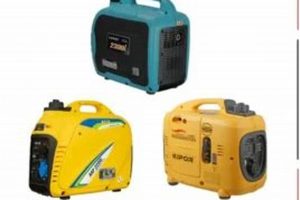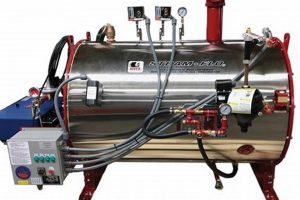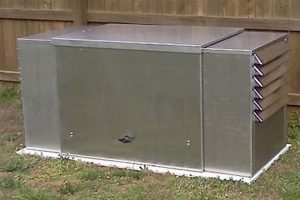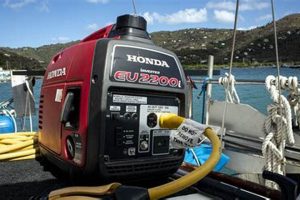Safe and proper power restoration during outages requires a thorough understanding of the interface between backup power sources and a building’s electrical system. This involves linking a mobile, independent power unit to the structure’s main power distribution center, enabling electricity to flow to essential circuits. For instance, a homeowner might utilize this process to power lights and appliances during a power outage caused by a severe storm.
Enabling temporary power access during grid failures provides critical support for essential services, safeguarding health, safety, and convenience. Historically, relying on backup power has evolved from rudimentary systems to sophisticated setups, highlighting the increasing need for reliable power solutions amidst growing dependency on electricity. Maintaining continuity of operations for businesses and vital services like hospitals further underscores the significance of a well-planned backup power strategy.
This article explores the key aspects of safely and effectively establishing temporary power. Topics covered include critical safety precautions, recommended equipment and procedures, as well as the regulatory landscape governing such installations. Further discussion will delve into specific scenarios, troubleshooting common challenges, and best practices for maintaining backup power systems.
Safety and Effectiveness Tips for Backup Power Installation
Careful planning and execution are paramount when integrating a portable generator with a building’s electrical system. These tips emphasize safe and effective practices to ensure reliable backup power and prevent damage to equipment or personal injury.
Tip 1: Consult Licensed Electricians: Electrical work poses inherent risks. Engaging qualified professionals ensures adherence to safety standards and code compliance, mitigating potential hazards.
Tip 2: Use a Transfer Switch: Never directly connect a generator to household outlets. A properly installed transfer switch isolates the generator from the utility grid, preventing backfeeding, a dangerous condition that can harm utility workers.
Tip 3: Proper Generator Sizing: Accurately assess power requirements for essential appliances and equipment. An undersized generator may overload, while an oversized one leads to inefficient fuel consumption.
Tip 4: Grounding and Bonding: Correct grounding and bonding are crucial for electrical safety. This prevents shock hazards and protects sensitive electronics from damage.
Tip 5: Regular Maintenance and Testing: Periodically test the generator and transfer switch to ensure they function correctly. Routine maintenance, including oil changes and filter replacements, extends the generator’s lifespan and reliability.
Tip 6: Fuel Safety: Store fuel in approved containers in well-ventilated areas away from ignition sources. Allow the generator to cool before refueling to prevent fire hazards.
Tip 7: Carbon Monoxide Awareness: Operate generators outdoors in well-ventilated locations. Never run a generator indoors or in enclosed spaces, as carbon monoxide buildup can be fatal.
Adhering to these guidelines ensures safe and reliable backup power during outages. Proper planning and execution mitigate risks and protect both personnel and equipment.
By understanding and implementing these recommendations, individuals and businesses can confidently establish robust backup power systems, promoting safety and peace of mind during unforeseen power disruptions.
1. Safety
Safety is paramount when connecting a portable generator to an electrical panel. Incorrect procedures can lead to severe consequences, including electrocution, fire, and carbon monoxide poisoning. These hazards pose significant risks to individuals and property, underscoring the need for meticulous attention to safety protocols. For instance, a poorly grounded generator can energize the metal frame, leading to electrocution if touched. Similarly, improper ventilation during generator operation can cause deadly carbon monoxide buildup within enclosed spaces. Failure to disconnect the main breaker before engaging a generator can result in backfeeding, energizing downed power lines and endangering utility workers.
Several critical safety measures must be observed. These include using a properly rated transfer switch to isolate the generator from the utility grid, preventing backfeeding. Adequate grounding of the generator and connected equipment is essential to prevent electrical shocks. Operating the generator in a well-ventilated area, preferably outdoors and away from windows and doors, minimizes carbon monoxide risks. Regular inspection and maintenance of the generator and associated wiring are crucial for identifying and mitigating potential hazards. For example, frayed wiring should be immediately replaced by a qualified electrician to prevent fire hazards. Using appropriately sized extension cords and avoiding overloading the generator prevents overheating and potential fires.
Prioritizing safety through diligent planning and execution minimizes risks. Consulting licensed electricians ensures adherence to local electrical codes and best practices. Understanding and adhering to manufacturer guidelines for safe generator operation is critical. Ultimately, a comprehensive approach to safety, incorporating professional guidance, proper equipment, and meticulous adherence to established procedures, is essential for protecting lives and property when utilizing portable generators for backup power.
2. Transfer Switch
Safe and reliable generator integration necessitates the use of a transfer switch. This device plays a crucial role in managing the flow of electricity, ensuring safe operation and preventing potentially hazardous situations. It serves as the critical link between the generator, the electrical panel, and the utility grid.
- Preventing Backfeeding
Backfeeding, the reverse flow of electricity from the generator into the utility grid, poses a significant danger to utility workers. A transfer switch prevents this by isolating the generator from the grid. For instance, during a power outage, the transfer switch disconnects the utility feed before allowing the generator to power the house, ensuring line workers are not exposed to live wires they believe to be de-energized.
- Overload Protection
Transfer switches are typically equipped with circuit breakers that protect against overloads. These breakers trip if the generator attempts to supply more power than its capacity, preventing damage to both the generator and connected appliances. For example, if a homeowner attempts to run too many appliances simultaneously, exceeding the generator’s rated output, the breaker in the transfer switch will trip, safeguarding the generator from damage.
- Simplified Operation
Transfer switches simplify generator operation by providing a centralized point for managing power distribution. Instead of manually plugging and unplugging individual appliances, the homeowner can select the circuits to power through the transfer switch. This ease of use is especially valuable during emergencies.
- Types of Transfer Switches
Two main types of transfer switches exist: manual and automatic. Manual switches require physical operation to change power sources, while automatic transfer switches detect utility power loss and engage the generator automatically. Automatic transfer switches offer greater convenience but come at a higher cost compared to manual switches.
By isolating the generator, providing overload protection, and simplifying operation, the transfer switch significantly enhances safety and convenience when integrating a portable generator with a homes electrical system. Choosing the appropriate type of transfer switch, whether manual or automatic, depends on individual needs and budget. Consulting a qualified electrician is crucial for determining the optimal solution and ensuring proper installation and adherence to safety regulations.
3. Correct Wattage
Generator selection hinges on providing sufficient power to operate essential appliances and equipment during an outage. Choosing a generator with inadequate wattage results in overloads and potential damage, while excessive wattage leads to inefficiency and unnecessary fuel consumption. Accurate wattage assessment is therefore critical for effective backup power planning.
- Calculating Power Requirements
Determining the correct wattage begins with calculating the combined power requirements of all intended devices. This involves identifying the wattage rating of each appliance and summing these values. For example, a refrigerator might require 700 watts, a sump pump 1,000 watts, and several lights a combined 200 watts, resulting in a total requirement of 1,900 watts. Online calculators and resources can assist with these calculations. Additionally, considering starting wattage, which is often significantly higher than running wattage for some appliances like refrigerators and air conditioners, is crucial to prevent the generator from stalling upon startup.
- Generator Wattage Ratings
Generators are rated in running watts and starting watts. Running watts represent the continuous power output, while starting watts denote the higher power required to start motor-driven appliances. Selecting a generator with sufficient starting wattage is crucial to prevent issues when powering appliances with high starting demands. For example, a generator with a 5,000-watt running rating and a 6,500-watt starting rating can handle appliances with higher initial power demands, like air conditioners, without overloading.
- Load Management
Even with a properly sized generator, managing the load is important. Avoid running all appliances simultaneously, especially those with high power demands. Prioritize essential appliances and stagger usage to prevent overloading. For example, running the refrigerator and sump pump simultaneously might be necessary, but delaying the use of a washing machine until those are off can prevent exceeding the generators capacity.
- Professional Consultation
Determining the correct wattage and selecting an appropriate generator can be complex. Consulting a qualified electrician is advisable, especially for complex electrical systems or when uncertainty exists. A professional can accurately assess power requirements, recommend suitable generator models, and ensure safe and compliant installation.
Accurate wattage assessment and generator selection are fundamental for ensuring reliable backup power during outages. Proper load management further optimizes generator performance and prevents overloads. These considerations, combined with professional guidance, ensure the safe and effective integration of a portable generator with a home’s electrical system, providing reliable power when needed most.
4. Proper Connection
Proper connection is paramount when integrating a portable generator with an electrical panel. This encompasses a precise sequence of steps and adherence to safety protocols to ensure both effective power delivery and the prevention of hazards. A methodical approach, often best implemented by a qualified electrician, mitigates risks and ensures the system functions as intended. Incorrect connection procedures can lead to equipment damage, fire hazards, and even electrocution. For instance, reversing polarity during connection can damage sensitive electronics, while improper grounding can create shock hazards. Using appropriately sized wiring and connectors is crucial for preventing overheating and ensuring efficient power transfer. A real-world example illustrating the importance of proper connection involves a homeowner who incorrectly wired a generator to their panel, resulting in a fire due to overloaded wiring.
The process involves several crucial steps. First, the generator must be properly grounded to prevent shock hazards. Then, the connection to the electrical panel, typically through a transfer switch, requires precise wiring according to the manufacturer’s instructions and local electrical codes. This often involves connecting specific wires to designated terminals within the transfer switch and the generator. Each connection must be secure and properly insulated to prevent short circuits and ensure reliable operation. For example, connecting the generator’s ground wire to the grounding rod or designated grounding terminal in the panel is essential for safety. Finally, verifying correct connections before energizing the system is crucial. This might involve using a multimeter to check voltage and continuity, confirming the proper flow of electricity.
Understanding and implementing proper connection procedures are fundamental for safe and effective generator integration. Overlooking these crucial steps can have severe consequences, ranging from equipment damage to life-threatening electrical hazards. Adherence to established procedures, manufacturer guidelines, and consultation with qualified professionals are essential for mitigating risks and ensuring the reliable and safe operation of backup power systems. This meticulous approach ultimately safeguards both individuals and property during power outages.
5. Legal Compliance
Legal compliance forms an integral aspect of connecting a portable generator to an electrical panel. Regulations exist to ensure safety, prevent hazards, and maintain the integrity of the electrical grid. Ignoring these regulations can lead to penalties, invalidate insurance claims, and create dangerous situations. Connecting a generator without adhering to local electrical codes, for instance, might violate building codes and result in fines. Furthermore, improper installation can create fire hazards or backfeeding into the utility grid, potentially endangering utility workers and leading to legal liability. A real-world example involves a homeowner who installed a generator without obtaining the necessary permits and inspections. Following a fire caused by faulty wiring, the insurance company denied the claim due to non-compliance with local electrical codes.
Specific regulations govern generator installations, often requiring permits and inspections. These regulations address critical safety aspects, such as proper grounding, transfer switch installation, and generator placement. Local authorities typically enforce these regulations, ensuring installations meet safety standards and prevent hazards. For example, some jurisdictions mandate the use of specific types of transfer switches and require inspections to verify correct installation and adherence to code. Failure to comply can lead to fines and legal action. Additionally, homeowners’ associations might have specific rules regarding generator usage, restricting operating hours or noise levels. Understanding and complying with these regulations, both at the local government and community levels, is essential for avoiding legal complications and ensuring safe operation.
Adhering to legal requirements for generator connections safeguards individuals, property, and the broader community. Compliance ensures installations meet safety standards, minimizing fire hazards, electrocution risks, and potential harm to utility workers. Consulting with licensed electricians and local authorities ensures adherence to applicable codes and regulations. Ultimately, legal compliance underscores a commitment to safety and responsible generator usage, protecting both the individual and the public interest. This proactive approach avoids legal issues, ensures insurance coverage validity, and fosters a culture of safety within the community.
Frequently Asked Questions
This section addresses common inquiries regarding the safe and effective connection of portable generators to electrical panels.
Question 1: Is professional assistance necessary for connecting a portable generator?
While technically feasible for individuals with electrical expertise, professional assistance is strongly recommended. Licensed electricians possess the knowledge and experience to ensure safe and compliant installations, adhering to local electrical codes and manufacturer guidelines. Their expertise minimizes risks and ensures the long-term reliability of the system.
Question 2: What is the importance of a transfer switch?
A transfer switch is crucial for safety. It isolates the generator from the utility grid, preventing backfeeding, a dangerous condition that can harm utility workers and damage equipment. It also simplifies generator operation and provides overload protection.
Question 3: How is the correct generator size determined?
Proper generator sizing requires calculating the combined wattage of all intended appliances and equipment. Consider both running wattage and starting wattage, especially for motor-driven appliances. Consulting a qualified electrician can assist in accurate load assessment and generator selection.
Question 4: What safety precautions are essential when operating a generator?
Operating a generator safely necessitates proper grounding, adequate ventilation to prevent carbon monoxide buildup, and keeping the generator dry to avoid electrocution hazards. Never operate a generator indoors or in enclosed spaces.
Question 5: Are permits required for generator installation?
Permit requirements vary by jurisdiction. Consulting local authorities is essential to determine specific requirements for generator installations, including transfer switch installations and inspections.
Question 6: What maintenance is required for a portable generator?
Regular maintenance, including oil changes, filter replacements, and periodic testing, ensures reliable generator operation. Following manufacturer recommendations for maintenance intervals is essential for maximizing the generator’s lifespan and performance.
Understanding these key aspects of generator connection and operation ensures safe and effective backup power during outages. Professional guidance and adherence to established procedures and regulations remain paramount for mitigating risks and safeguarding both individuals and property.
For further information and specific guidance, consult licensed electricians and local authorities. Their expertise ensures compliance with applicable regulations and promotes safe and reliable backup power solutions.
Connecting a Portable Generator to an Electrical Panel
Establishing a reliable backup power source requires careful consideration of various factors. Safe and effective integration of a portable generator with a building’s electrical system necessitates a thorough understanding of safety protocols, proper equipment utilization, and adherence to legal regulations. This article has explored the critical aspects of this process, emphasizing the importance of transfer switches, accurate wattage assessment, proper connection procedures, and compliance with local electrical codes. Careful planning, execution, and ongoing maintenance are essential for ensuring reliable backup power during outages.
Reliable access to electricity is paramount in modern society. Power outages can disrupt essential services, impacting safety, comfort, and economic stability. Investing in robust backup power solutions, coupled with diligent adherence to safety and regulatory guidelines, provides critical resilience against these disruptions. Proactive planning and preparation empower individuals and communities to navigate power outages effectively, minimizing disruption and safeguarding well-being. A well-executed backup power strategy ensures continuity of essential operations and enhances overall preparedness for unforeseen events.






